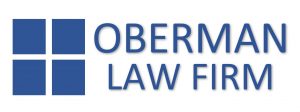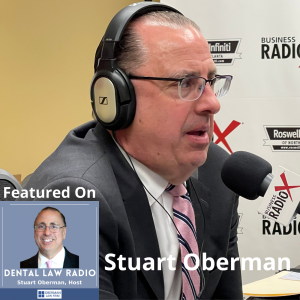
Teledentistry (Dental Law Radio, Episode 1)
On the premier episode of Dental Law Radio, host Stuart Oberman surveyed various modalities of teledentistry, regulatory issues, the risks of “store and forward” or asynchronous teledentistry, and much more. Dental Law Radio is underwritten and presented by Oberman Law Firm and produced by the North Fulton studio of Business RadioX®.
TRANSCRIPT
Intro: [00:00:02] Broadcasting from the Business RadioX Studios in Atlanta, it’s time for Dental Law Radio. Dental Law Radio is brought to you by Oberman Law Firm, a leading dental-centric law firm serving dental clients on a local, regional, and national basis. Now, here’s your host, Stuart Oberman.
Stuart Oberman: [00:00:26] Hello everyone, and welcome to Dental Law Radio. There is so much going on in the industry that it’s hard to pick a topic that is really top of mind. There’s probably 11 or 12 topics that we’re going to cover on this podcast. But I think today, with the advent of COVID-19, one of the biggest areas that we’ve really, really seen explode is teledentistry. It’s been, you know, out in the collateral side for a couple of years now. But I think that with COVID-19 and all of the issues that surrounded that, I think the most relevant topic today is teledentistry, and it is absolutely here to stay.
Stuart Oberman: [00:01:07] So, we get a lot of questions, you know, what is tele dentistry? And how does it affect us? And what are the modalities? So, I want to run through a couple of things really to give a 10,000 foot view of what teledentistry is and some of the things that are really the complexities of it. This is probably a four hour topic, but we’re going to keep it brief today. And we can sort of expand out, you know, in other podcasts. But I think today we’re just going to give a 10,000 foot view as to where we’re at on it.
Stuart Oberman: [00:01:35] So, you know, teledentistry in the United States has exploded. With the advent of COVID-19, like I said before, teledentistry is going faster than ever. It provides faster care. The concept was originally to keep patients out of the emergency rooms, which it certainly has done. But, you know, there’s a lot, a lot of state regulatory issues. No matter what state you’re in, I’ll venture to say it’s going to be different. And each board is different. Each state regulatory is different. For the health care side, what’s expected was not expected. But we’re going to cover some of the modalities in a little bit.
Stuart Oberman: [00:02:11] So, what are the concerns when you jump into teledentistry? You know, what are the concerns? Obviously, compliance. You’ve got HIPAA issues, you’ve got licensing issues, credentialling. You’ve got technology, which is changing every day it seems like. And then, of course, what’s the malpractice exposure, which is really yet to be explored. But, you know, like I said from the start, it’s here to stay. It’s not going anywhere. And the question is, how do our doctors want to implement this into their practice?
Stuart Oberman: [00:02:43] And the bottom line is, it’s either you adopt it or you don’t and you’re left behind. So, you know, we get this question, what are the modalities? So, what are the modalities? You know, what are the different types of teledentistry and how do we implement it? So, you’ve got a couple of things.
Stuart Oberman: [00:03:02] You’ve got live video, which the term of art is synchronous. So, synchronous, in it of itself, is live two-way interaction where the provider is using audiovisual technology. There are so many ways nowadays to provide this technology. If you’re going on your iPhone, we’ve got iPads, we’ve got everything imaginable that can have literally two-way conversation. And I think to limit yourself to one particular way to adopt that technology, I think, you’re hurting your own cause.
Stuart Oberman: [00:03:36] So, one of the most popular and probably one of the most dangerous ones to really implement because of regulatory matters is probably what we call Store and Forward. Store and Forward which is asynchronous. So, the asynchronous side is transmission of recorded health information, X-rays, photographs, video. This is where you have got to be compliant. You can’t even begin to do these modalities if you’re not in compliance.
Stuart Oberman: [00:04:05] So, again, under the asynchronous, basically, it’s digital impressions through a secured electronic communications systems to a dentist. Basically, it’s where the dentist goes onto a platform, as if it’s a waiting room, and literally picks up patient data. And then, it’s reviewed and then there is communication with the patient. The problem is, is that this is not face-to-face. It’s delayed communication. And my concern on this particular modality is the loss of transmission. If you’re just emailing patients back and forth, I think you’ve got some regulatory issues, that you’ve got some concerns that you need to address. And then, I think that you’ve got to determine what your purpose is as far as these two modalities.
Stuart Oberman: [00:04:53] So then, you know, on a third modality, you’ve got Remote Patient Monitoring, what we call an acronym of RPM. So, this is basically personal health and medical collection data from an individual in one location via electronic communication. So, this is transmitted to a dentist in a different location. You know, for years, years, and years, our dentists getting information on their computers, laptops, iPhones, iPads. And this is sort of bringing it to a whole another secured level where this has to be done on a secured platform. We’ve got patient information is coming back and forth and it’s got to be encrypted. So, there are a lot, a lot of security issues, a lot of technical issues, that I think have outgrown the iPhone concept because of the complexities.
Stuart Oberman: [00:05:53] So then, your final modality is your mobile health or mHealth, which is mobile communication by cell phones, tablets, and other forms of electronic devices. So, that’s pretty simple in it of itself. But you have to determine how that is going to be done, whether you’re going to be getting information off of a platform, whether you’re going to be setting up face-to-face meetings with your patients, which we always recommend for regulatory compliance issues.
Stuart Oberman: [00:06:20] So, you know, in today’s world where our doctors are asking, “Well, we’re not going to render care for teledentistry, but we want to use it as a screening method for our patients.” So, I want to give a couple of examples of how our clients have implemented this during COVID-19. You can use a screen process in multiple ways.
Stuart Oberman: [00:06:45] Example, so a lot of our doctors had questions regarding COVID. And I’ll use that as sort of the nowadays thing. But, you know, this may change as we open up, as we get the shots, as other things come about, and there’s always going to be the next problem. So, the question is, how do I take this right now with what we’re talking about and implement that down the road?
Stuart Oberman: [00:07:12] So, example, so here’s some questions. So, you have your patient come in your office. And in the lobby, you’re asking them questions. Well, my question is, “Why can’t you do this via remote communication?” I mean, you can ask this clearly over communications, over the internet, direct access. So, do you have a fever, cough, shortness of breath? Now, are you going to have a patient come into your office and ask him that question, when you could screen these through the use of teledentistry? Have you been tested for COVID? has a family member been tested? Have you been exposed to anyone with symptoms of COVID-19?
Stuart Oberman: [00:07:48] Again, there’s certain areas of the country, you know, obviously, the northeast is a little bit tighter. In the south, we say that COVID never hit the south. But, you know, things out west was a little bit tighter. So, these are things you got to implement. You know, again, a question, have you traveled to another country? Are you a health care worker, in a high risk job, law enforcement, trucking, grocery store? You know, in some aspects in some states, teledentistry can be used to prescribe antibiotics and pain medication. Again, that’s going to depend on your state law. That’s going to depend on the process for keeping your patients out of the H.R. These are some very, very, very generic discussions regarding teledentistry.
Stuart Oberman: [00:08:37] But as practices grow, as technology becomes more and more accessible, as security becomes better, as the process becomes better, it’s going to be clunky at first. To grow, to stay at the top of patient care, you’re going to have to implement teledentistry at some point. And that will depend on the state law or how you develop your practice, provide patient care, patient service.
Stuart Oberman: [00:09:10] You know, one way to use teledentistry is if you have a patient that is constantly having problems after a surgery. Let’s say, you got a bad root canal and you’re having trouble with the B2 canal. Well, why not get on teledentistry and talk to that patient face-to-face? It’s great to do email. A lot of times our doctors will use their staff members to do this, which becomes sort of problematic because then there’s ongoing problems.
Stuart Oberman: [00:09:39] Cut to the chase. Get on one-on-one with the patient, direct communication, figure out what the problem is, and get it done. Because as these problems go on, “Well, I’m busy. I don’t have time to bring them in. My patient is booked.” You need to get them in. And one way to do this is get them over the internet, get them on the screen, talk to them, see their emotions, see what the problems are. And maybe something is not even related to you. But this is one aspect of teledentistry where you can clearly, clearly help that patient care.
Stuart Oberman: [00:10:14] And then, we’re seeing a lot of our doctors use teledentistry as a customer service tool, confirming appointments, any concerns, pre-screens, insurance information. Sometimes you’re just not going to get it over the phone, you need to see it. A lot of times in our office, we’ll do some remote Zoom calls and we got the documents to share a screen in front of us. So, develop those technologies. It is all for patient care. That’s what it’s about. That’s what you’re in the business for, at the end of the day, is patient care and provide the best possible service you can.
Stuart Oberman: [00:10:47] So, those are just a couple of things that we want to touch base on teledentistry. Again, we can talk hours on teledentistry. But this will give our guys a good overview, a good 10,000 foot view. So, we’re going to be covering other areas in a podcast that we feel relevant, top of mind, and, really, on the forefront of a lot of things. But that’s going to conclude our podcast for today.
Stuart Oberman: [00:11:14] Again, these segments are going to be relatively brief. We want to go ahead and get everything at the forefront, get our doctors thinking about everything, what’s going on. But you can check out other podcasts at dentallawradio.com. And if you need to get in touch with us, you know, reach out, give us a call. Call our main number, 770-554-1400, Oberman Law Firm. Or send an email to me directly, Stuart, S-T-U-A-R-T, @obermanlaw.com. And I want to thank everyone for joining us today. We want to continue these podcasts and bring relevant information top of mind that’s happening every day in our dental practices which we have access to. And we look forward to seeing you on the radio, as we say. Have a great day. Thank you.
About Dental Law Radio
Hosted by Stuart Oberman, a nationally recognized authority in dental law, Dental Law Radio covers legal, business, and other operating issues and topics of vital concern to dentists and dental practice owners. The show is produced by the North Fulton studio of Business RadioX® and can be found on all the major podcast apps. The complete show archive is here.
Stuart Oberman, Oberman Law Firm

Stuart Oberman is the founder and President of Oberman Law Firm. Mr. Oberman graduated from Urbana University and received his law degree from John Marshall Law School. Mr. Oberman has been practicing law for over 25 years, and before going into private practice, Mr. Oberman was in-house counsel for a Fortune 500 Company. Mr. Oberman is widely regarded as the go-to attorney in the area of Dental Law, which includes DSO formation, corporate business structures, mergers and acquisitions, regulatory compliance, advertising regulations, HIPAA, Compliance, and employment law regulations that affect dental practices.
In addition, Mr. Oberman’s expertise in the health care industry includes advising clients in the complex regulatory landscape as it relates to telehealth and telemedicine, including compliance of corporate structures, third-party reimbursement, contract negotiations, technology, health care fraud and abuse law (Anti-Kickback Statute and the State Law), professional liability risk management, federal and state regulations.
As the long-term care industry evolves, Mr. Oberman has the knowledge and experience to guide clients in the long-term care sector with respect to corporate and regulatory matters, assisted living facilities, continuing care retirement communities (CCRCs). In addition, Mr. Oberman’s practice also focuses on health care facility acquisitions and other changes of ownership, as well as related licensure and Medicare/Medicaid certification matters, CCRC registrations, long-term care/skilled nursing facility management, operating agreements, assisted living licensure matters, and health care joint ventures.
In addition to his expertise in the health care industry, Mr. Oberman has a nationwide practice that focuses on all facets of contractual disputes, including corporate governance, fiduciary duty, trade secrets, unfair competition, covenants not to compete, trademark and copyright infringement, fraud, and deceptive trade practices, and other business-related matters. Mr. Oberman also represents clients throughout the United States in a wide range of practice areas, including mergers & acquisitions, partnership agreements, commercial real estate, entity formation, employment law, commercial leasing, intellectual property, and HIPAA/OSHA compliance.
Mr. Oberman is a national lecturer and has published articles in the U.S. and Canada.
Oberman Law Firm
Oberman Law Firm has a long history of civic service, noted national, regional, and local clients, and stands among the Southeast’s eminent and fast-growing full-service law firms. Oberman Law Firm’s areas of practice include Business Planning, Commercial & Technology Transactions, Corporate, Employment & Labor, Estate Planning, Health Care, Intellectual Property, Litigation, Privacy & Data Security, and Real Estate.
By meeting their client’s goals and becoming a trusted partner and advocate for our clients, their attorneys are recognized as legal go-getters who provide value-added service. Their attorneys understand that in a rapidly changing legal market, clients have new expectations, constantly evolving choices, and operate in an environment of heightened reputational and commercial risk.
Oberman Law Firm’s strength is its ability to solve complex legal problems by collaborating across borders and practice areas.
Connect with Oberman Law Firm:
Company website | LinkedIn | Twitter
















